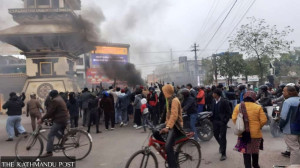National
High invalid votes and low turnout prompts poll commission to run voter education
A total of 7,500 volunteers will be sent door-to-door for over a month from the last week of September to the election day on November 20.
Binod Ghimire
The Election Commission has decided to conduct in-person and virtual voting education programmes for the upcoming House of Representatives and provincial assembly elections in an attempt to reduce the number of invalid votes.
In lack of adequate budget, the commission had used the mainstream media and social media platforms to disseminate information on voting before the May 2013 local elections, shunning door-to-door campaigns, considered the most effective way to educate the electorate.
Invalid votes were as high as 13 percent in Kathmandu Metropolitan City, Chitwan Metropolitan City and Biratnagar Metropolitan City for the mayoral positions in the recent local elections while the overall invalid votes stood at 3 percent. The voter turnout in local elections was 70.9 percent, lower than the previous local polls.
The commission says it has prepared a broad design for voter education to be conducted virtually and by mobilising educators physically.
“We have decided to conduct a broad voter education programme this time,” Surya Aryal, assistant spokesperson at the commission, told the Post. “We have sought around Rs550 million from the Finance Ministry for the purpose.”
According to him, how the voter education programme moves ahead will depend on the amount of budget the ministry releases.
In its conceptual framework, the commission has decided to broadcast public service announcements from the national and local radio and television stations, publish advertisements in newspapers and online news media and develop contents for Youtube. Similarly, it also plans to disseminate information through different social media platforms.
As many as 18 million Nepalis have been registered with the Election Commission to vote in the November 20 polls, through which 275 members will be elected to the House of Representatives and 550 to seven provincial assemblies.
In the House of Representatives, 165 will be elected under the direct election system and 110 through the proportional representation system. Similarly, 330 members for the seven provincial assemblies will be elected under the direct election system and 220 through the proportional representation system. There will be four different ballot papers—one each for proportional and the first-past-the-post system for both provincial assemblies and the House of Representatives.
Aryal, who also oversees the voter education department at the commission, said they have assessed that the virtual medium might not be accessible to every voter and in-person activities are more effective, so the commission is preparing to mobilise volunteers at the ward level. The volunteers will teach the voters how to cast their ballots so as to ensure that their votes do not become invalid.
The commission plans to mobilise close to 7,500 volunteers for over a month. The volunteers will reach as many households as possible from the last week of September to the election day to impart information on voting properly.
“Our focus would be towards increasing the voter turnout and decreasing the number of invalid votes,” said Aryal. “We have designed the voter education programme accordingly.”
On an average, 74.16 percent voter turnout was reported in the local polls that were held in three phases in 2017. The highest voter turnout reported since the 1991 elections was in the second Constituent Assembly in 2013 when 78.74 percent of listed voters exercised their franchise.
Experts say teaching people how to register for a vote, put the stamp on the ballot paper on the symbol of the candidate of their choice and fold the ballot paper properly before putting it into the ballot box is necessary. In many instances people don’t even know stamping outside the box of the particular election symbol makes a vote invalid, they say.
However, the voting information alone is not adequate, there is a need for proper voter education, according to Kapil Shrestha, a professor of political science at the Tribhuvan University.
“Imparting information on how to vote is necessary but voter education will be incomplete without informing the people why to vote,” Shrestha, also the chairperson of the National Election Observation Committee, told the Post. “Getting to enjoy the right to franchise is a pride of a citizen and an opportunity to elect the people to govern.”
He said informing the voters that every vote matters in the elections and their one vote can be instrumental in electing or defeating a candidate is the most important part of voter education.
Nepal’s invalid votes are multiple times higher than the normal threshold.
As many as 84 parties have been registered at the commission for the November 20 federal and provincial assembly elections.
Those, who have worked as election observers, say it was wrong for the commission not to conduct in-person voter education campaigns in the local elections.
Pradip Pokharel, chairperson of the Election Observation Committee Nepal, said the commission seems to have realised the mistake and is planning to mobilise the volunteers to reach out to voters this time.
“The higher invalid vote percentage and lower voter turnout in the recent election shows there is a need for an effective voter education programme. The commission should not wait until the last moment to launch the programme,” he told the Post. “Even political parties should be conducting voter education by mobilising their cadres and through mainstream media and social media.”
The parties and the candidates can publish and broadcast their publicity materials in the media but there are rigid provisions in place in the election code of conduct prepared by the commission.
A political party can advertise a publicity material of maximum of one minute in length both on FM radio and Television. Similarly, they can publish advertisements measuring 7 inch by 7 inch in one newspaper per day.
The same applies to the election candidates.
“People can get informed hugely through advertisements. There has to be some restrictions on advertisements to stop extravagance,” Pokharel said. “However, such restrictions must not be so rigid that it discourages advertisements.”




 5.46°C Kathmandu
5.46°C Kathmandu







%20(1).jpg&w=300&height=200)







